Freezing garden or store bought veggies is a solid way to keep them fresh, but if you skip one step, blanching, you could end up with mushy disappointment later. Blanching means giving your vegetables a quick dunk in boiling water, then chilling them instantly to stop the cooking. Through plenty of trial and error, I’ve realized this method preserves the color, crunch, and flavor way better than freezing them raw. If you want frozen veggies that actually taste like vegetables, here’s how to master the blanching process before freezing.

Why Blanching Before Freezing Matters
Blanching does more than just help veggies look nice. There’s science behind why that short hot soak helps your frozen vegetables keep their best qualities. Raw veggies have natural enzymes that break down flavor, color, and crunch, even in the freezer. Blanching quickly shuts those enzymes down, so your food comes out tasting fresher when thawed. It also helps clean dirt and bacteria, brightens colors, and softens things just enough so they freeze smoothly without turning limp or soggy later.
How to Blanch Vegetables Properly (Step by Step)
Here’s the simple method I use whenever I’m stashing garden bounty for winter. With this approach, freezer burn and limp veggies have become rare in my kitchen. Try these steps too, and you’ll notice the difference:
- Gather your gear: Large pot, a slotted spoon or strainer, a big bowl of ice water, kitchen towels for drying, and airtight freezer containers or bags.
- Prep your veggies: Wash them well, trim rough spots, peel if needed, and cut into even pieces so they cook at the same rate.
- Boil water: Use plenty of water—at least a gallon for every pound of vegetables. Wait for a rolling boil before adding veggies.
- Drop in veggies: Add small enough batches that the water keeps boiling. Start your timer right away (that’s important; see the chart below).
- Cool instantly: As soon as time’s up, scoop veggies into the ice water to stop cooking fast and preserve bright colors and crispness.
- Drain and dry: Put veggies on clean towels and pat dry, because too much moisture brings on freezer burn and makes veggies stick together. Don’t skip this part.
- Package and freeze: Spread out smaller pieces in a single layer on a tray for individual freezing if you want, or just portion out and label bags with dates so you know what’s what.
I like to use a blanching pot: You can find these on Amazon – here is a link to a few of them Blanching Pots
Freezing Vegetables Made Simple: Blanching Times Chart
Each vegetable needs its own blanching time. Too short, and enzymes survive, so your veggies degrade. Too long, and you’re cooking instead of preserving. Here’s a handy guide you can use for the most common vegetables:
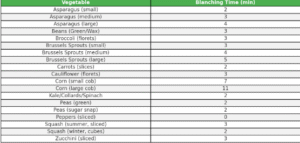
Here is a downloadable version: Blanching Times Chart
Keep a timer handy, because giving them even an extra minute can change their texture—sometimes not for the better.
10 Vegetables You Should Always Blanch Before Freezing
Some veggies absolutely need a blanch if you hope to keep them tasting, looking, and feeling great out of the freezer. My tried-and-true top ten are below, and each one has let me down when frozen raw but comes out tasting fresh after a quick blanch:
- Green beans
- Broccoli
- Cauliflower
- Carrots
- Asparagus
- Peas
- Zucchini
- Spinach and other leafy greens
- Corn (kernels or cobs)
- Brussels sprouts
Blanching these will save you from mushy, faded, or tough results. Give them their time in boiling water, and you’ll be pleasantly surprised.
Which Vegetables Need Blanching Before Freezing (and Which Are Fine Raw?)

Most veggies get a big boost from blanching, but there are a few forgiving types that can go straight into the freezer if you’re short on time. Here’s a helpful rundown:
- Need Blanching: Pretty much all greens, green beans, root veggies (except onions), corn, most veggies in the cabbage family, summer squash, and zucchini.
- Can Be Frozen Raw: Onions, all types of peppers, tomatoes (if they’re for cooked recipes), herbs (especially when they’ll be cooked), and whole garlic cloves.
Peppers and onions can hang in there frozen and still be useful in recipes, but their texture will soften either way. If your plan is to toss them in soups, stir-fries, or sauces, skipping blanching works out fine for these.
Extra Tips for Blanching Vegetables and Freezing Success
- Go with lots of water—one gallon per pound is a good rule.
- Always use real ice water after boiling; cold tap water isn’t enough to cool them off quickly.
- Work in small batches so all the veggies blanch evenly and you don’t lose the boil.
- Label every bag or container with both the veggie type and the freeze date. This will save you time and frustration later.
- Don’t bother salting your blanching water, as that’s not necessary and could change the final texture a bit.
❓ Problem Solving and Common Questions
I hear certain questions all the time. If you’re learning or still unsure about freezing veggies, these points will guide you in the right direction:
How long should you blanch veggies before freezing?
It totally depends on your veggie and the size of your pieces. Most fall into the 1–4 minute range, but heftier or denser types (like cobs of corn or Brussels sprouts) may need more. Double check a chart—like the one provided earlier—for your best shot at success.
Does the water have to be boiling?
Absolutely. A real, rolling boil is what you want. Skipping that keeps the enzymes alive, and you might not halt the process fast enough. I never add vegetables until I see big bubbles and lots of steam.
What are the biggest mistakes to avoid?
- Using too little water, which cools everything down and doesn’t truly blanch the veggies.
- Not putting veggies straight into ice water, so the cooking keeps going indefinitely.
- Packing veggies into bags while still wet—this means ice clumps form and veggies stick together.
- Misjudging the blanching time. Set a timer every time.
What’s the proper method for blanching?
Don’t overthink it. Fast boil with loads of water, small batches, chill quickly in ice water, dry well, freeze in portions you’ll actually use, and label. That’s it!
Blanched vs. Raw: Which Freezes Best?
If you’re wondering whether the process is worth it, here’s my summary from years of personal experience:
- Blanched veggies: Stay colorful, crunchy, and tasty. They can also last up to a year without losing quality.
- Raw, unblanched: Lose color and flavor, go limp, pick up odd flavors, and have a short freezer life—maybe just a few months for most types.
Unless you’re in a real hurry or working with onions and peppers, spend the few extra minutes blanching and taste the difference at dinner time.
Do You Really Have to Blanch Veggies?
No one’s forcing you, but I’ve rarely been happy skipping this step. There are cases—like onions, peppers, or chopped herbs for cooked recipes—where unblanched works. But for most vegetables, a quick blanch pays off with better flavor, looks, and texture every single time you open the freezer.
What Happens if You Freeze Without Blanching?
Colors fade, flavors drop off, and textures get watery or chewy when you don’t blanch. Nutrient loss happens faster, too. I’ve frozen green beans and broccoli raw before, only to find limp, browned clumps after a few months. Not worth it.
Frequently Asked Questions
Can you save blanching water for soups or stocks?
It’s usually not a good idea, because it’s colored and flavored by whatever you blanched, and sometimes picks up residue you don’t want in your soup. Clean, fresh water is better for broths.
Is steaming a legit blanching option?
Steaming can work, especially for delicate vegetables. Use the same amount of time you’d use for boiling, then chill in ice water right afterward for the same benefits.
How about using a microwave for blanching?
I wouldn’t. Microwaves don’t heat evenly, and most can’t bring water to that true rolling boil you need for solid enzyme control. Stick with stovetop boiling or steaming.
Your veggies (and your future self) will thank you for a few extra minutes spent on blanching before freezing. Once you taste the fresh flavor and snap of a dinner made with these frozen vegetables, you’ll see: it’s a habit worth keeping!
© 2025, Teresa. All rights reserved.
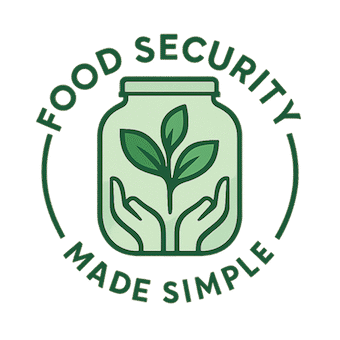
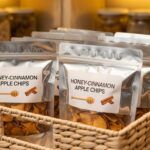
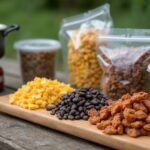


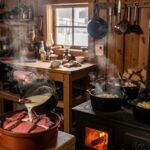
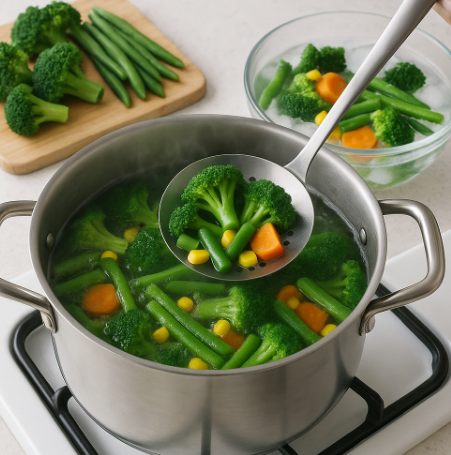
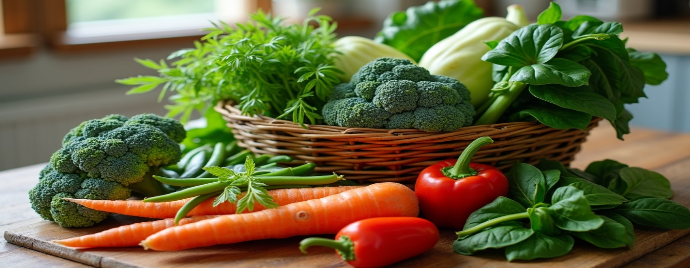
That’s an interesting consept you have with blanching before freezing, I never knew this method existed?
What about leafy vegetables such as salad greens, would they benefit from blanching or are they too weak in consistency to try this method? And what about fruit, would that also benefit from blanching, or just the veges?
How long can the veges be frozen for after blanching? is there a time limit such as 6 months?
Thanks Helen
Great questions! Leafy greens like salad lettuce don’t blanch or freeze well, but sturdier greens (like kale or spinach) do. Most fruits don’t need blanching—just prep and freeze. As for veggies, once blanched they’ll usually keep well in the freezer for 8–12 months.
Wow, this was such a helpful guide! I never realized how crucial blanching is before freezing—especially to keep veggies crisp, colorful, and flavorful. I’ve always dumped things straight into the freezer and ended up with sad, mushy textures. Your detailed steps and blanching chart are exactly what my meal-prep routine needed. Quick question: do you have a tip for veggies like zucchini or corn—should they always be blanched, or can they sometimes go in raw? Thanks for sharing such practical wisdom. Looking forward to trying this and seeing (and tasting!) the difference!
I’m so glad you found it useful! Zucchini and corn both do best with blanching—it really helps lock in flavor and texture. You’ll notice a big difference once you try it!